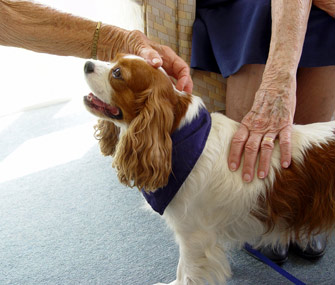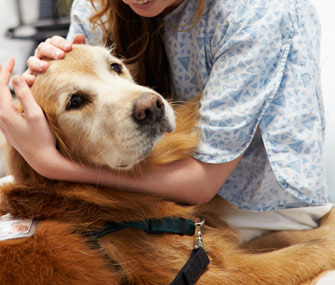The Making of a Therapy Dog
Published on March 05, 2014

Q: I want to use my dog as a therapy dog in a school or hospital, but I’m not sure he has the personality. What makes a good therapy dog, and how do they get certified?
A: Therapy dogs, or visitation pets, have the potential to make a monumental difference in people’s lives. I have a Pug named Willy who has been certified for nearly five years as a Pet Partners therapy dog. He has impacted the lives of countless individuals in various walks of life, from the young to the elderly. He can break down barriers with people and reach them on a “heart level” in a way that would be impossible without him. He has inspired numerous people, from leading youths on probation toward making better choices to bringing comfort and companionship to those who are sick or in long-term care.
Therapy Dog Versus Service Dog
Before talking about what makes a therapy dog, it’s important to understand what a therapy dog is not. A therapy dog is not a service dog, who is allowed to go into public spaces to assist his person with a specific need. There is a common misconception that dogs certified as visitation animals get the same access as service animals, but there is a clear distinction between the two.
Service dogs perform a task or meet a need for an individual with a disability; thus, they are given access to public spaces to accompany their people. Service animals assist with conditions like autism, post-traumatic stress disorder, hearing or visual impairments, seizures, diabetes and limited mobility. In comparison, therapy animals are given limited access to public spaces but usually have a certification making it more likely that facilities will allow their access. The purpose of a therapy dog is to visit individuals or places to provide companionship, support and, in some cases, education to those they come into contact with. Therapy dogs are used in a variety of situations, including at hospitals, nursing homes and schools. They also help individuals deal with grief in the wake of natural disasters and other traumatic events.
Standards and Certification
The type of certification required for a therapy dog is varied and depends in large part upon the individual facility. Some facilities have strict requirements, while others are more open. It’s important to contact your facility of choice to ascertain its standards. There are numerous certification programs, from nationally recognized initiatives like Pet Partners or Therapy Dogs International to local courses. Some programs, such as Pet Partners, recommend undergoing foundational certifications, such as the American Kennel Club Canine Good Citizen test, before attempting their certification. Some facilities require only a “meet and greet” with a dog or Canine Good Citizen certification to allow an animal to visit residents.
In some certifications, like the Pet Partners test, limiting designations may be placed on individual animals’ certifications, noting that, for example, they perform best in a predictable environment or need to be held during visits. On the other hand, one of my friends has a Pet Partners-certified Golden Retriever who visits psychiatric wings and is deployed for grief support during disasters. Her dog’s work required the canine to meet a strict certification standard that few dogs could handle and is difficult to achieve.
Many therapy dog programs offer training courses to prepare both handlers and their dogs for certification and visitation. Preparatory training will home in on the specific requirements of becoming a therapy dog team.
The Right Fit

In general, here are the qualities to look for in a therapy dog:
Health. Many therapy certifications require a physical from a veterinarian to screen for disease, pain and illness. Health requirements often include a record of vaccinations and parasite control and a fecal exam. There may be other requirements, depending on the program, such as animals fed a raw diet being excluded because of salmonella concerns. A dog’s cleanliness and grooming, including nail trimming, also will be assessed.
Sociability. Ideal candidates are friendly, outgoing and confident and enjoy being around people. Dogs with a history of aggression or training that encourages aggression are excluded in most certifications. Fearful dogs also are not ideal therapy candidates, as the animals should both enjoy visitations and be able to cope with the inevitable challenges that come from working with numerous individuals. If a dog gets excited, it’s important that he calms down readily and can be directed away from the excitement source, such as by willingly leaving a person or dog when asked. A dog’s stress levels will be assessed throughout testing to ensure that the animal enjoys the work and that it’s not anxiety-provoking for him to be in a visitation setting.
Response to handling. Dogs should seek and enjoy attention from people and tolerate different types of petting, such as vigorously excited stroking and handling of sensitive areas like ears and paws. Dogs should also remain relaxed with restraining hugs. Some tests even look at a dog’s ability to recover when surprised, such as when shoved from behind when he’s not looking. Canines also are assessed for their ability to remain comfortable with various types of people and personalities, including boisterous and pushy individuals, those with clumsy and awkward movements, and those using mobility aids, such as walkers, canes and wheelchairs.
Training. Dogs are tested on a series of skills. Most tests build on the Canine Good Citizen basics and add difficulty. In Pet Partners, dogs must walk on a loose leash, including for turns and stops, and walk through a crowd while remaining calm. Canines are assessed for their ability to approach people and other dogs calmly and remain unperturbed with numerous distractions, such as loud or sudden noises. Dogs must respond to cues to sit, lie down, leave it, come when called and stay in place, even with a distraction. Dogs also are evaluated for their ability to politely take a treat from a stranger.
Most certification tests do not allow treats or corrective training collars to be used. Extensive prior training is often required to get the dog to respond readily to his handler’s cues.
Breed. The only limitation on breed is breed-specific legislation that, unfortunately, can impact some dogs’ access to certain facilities. Otherwise, the breed of dog doesn’t impact suitability as a visitation animal. All sizes of canines can make excellent candidates, from a Popsicle-sized Chihuahua to a pony-sized Mastiff. For the dog’s well-being, it’s important to be aware of the size of the animal in relation to his work, as smaller and more fragile dogs require greater care around individuals who can more easily harm them, like young children.
Handler Suitability
It’s not only the dog who is evaluated for his suitability for therapy work, but also the handler for her ability to successfully work with her animal and with other individuals. During testing, the handler should remain cognizant of her dog’s emotional and physical well-being and, like her dog, demonstrate excellent social skills with people.
More on Vetstreet.com:





